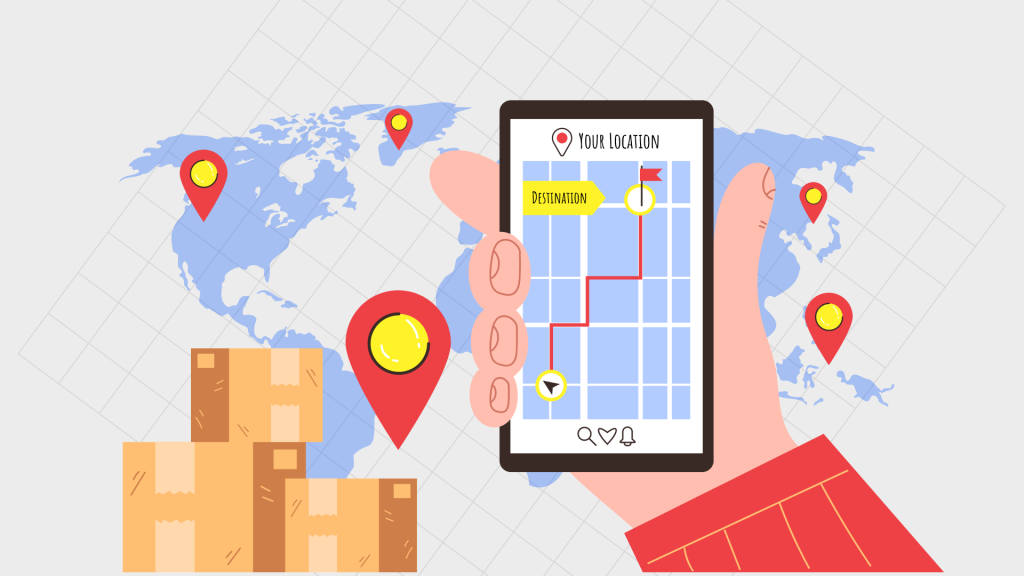In the dynamic world of ecommerce, logistics stands as the backbone that connects virtual storefronts to the doorsteps of millions of customers worldwide. As technology and consumer behavior evolve, so too does the landscape of ecommerce logistics. In this article, we delve into the latest ecommerce logistics trends 2024 and innovations shaping the future of this critical industry. From sustainable practices and cutting-edge automation to the relentless pursuit of efficiency, join us as we explore the key developments driving ecommerce logistics into the next era of retail.

Automation And Robotics In Ecommerce Logistics
Implementing automation and robotics in warehousing and fulfillment requires careful planning, investment, and integration. Here’s a step-by-step guide on how a business can successfully implement these technologies:
Assessment and Strategy Development
- Identify Pain Points: Analyze your current warehousing and fulfillment processes to identify areas where automation and robotics can provide the most value, such as order picking, packing, sorting, or inventory management.
- Set Goals: Define clear objectives for implementing automation, such as improving order accuracy, reducing processing times, or handling peak-season demands more efficiently.
- Create a Roadmap: Develop a detailed plan that outlines the timeline, budget, and specific technologies you intend to implement.
Technology Selection
- Research: Explore available automation and robotics solutions that align with your goals and business requirements. Consider factors such as scalability, compatibility with existing systems, and the ability to adapt to future needs.
- Vendor Evaluation: Choose reputable vendors with a track record of successful implementations. Request demonstrations and references to ensure their solutions meet your needs.
Process Redesign
- Workflow Analysis: Redesign processes to optimize them for automation. Rethink how tasks are performed, considering factors such as item placement, order sequencing, and robot interaction points.
- Standardization: Establish standardized procedures to ensure consistency in operations and facilitate the integration of automated systems.
Integration and Testing
- Software Integration: Integrate the new automation and robotics systems with your existing warehouse management system (WMS) or enterprise resource planning (ERP) software. This integration is essential for data sharing and process coordination.
- Testing and Optimization: Conduct thorough testing to identify and address any issues before full deployment. Fine-tune the systems for optimal performance, accuracy, and safety.
Training and Workforce Management
- Employee Training: Train your workforce to work alongside the new technologies, whether it’s operating robots, monitoring processes, or managing exceptions. This ensures a smooth transition and reduces resistance to change.
- Skill Enhancement: Invest in upskilling and reskilling employees to take on higher-level tasks that complement the automated processes, such as system monitoring, maintenance, and process optimization.
Change Management
- Communication: Clearly communicate the reasons behind the automation implementation to your employees. Address concerns and provide a clear vision of how their roles will evolve alongside the new technologies.
- Employee Engagement: Involve employees in the process by seeking their input and feedback. This fosters a sense of ownership and collaboration.
Monitoring and Continuous Improvement
- Data Analytics: Utilize data collected from automated systems to monitor performance, identify bottlenecks, and gain insights into areas for improvement.
- Iterative Approach: Continuously refine and optimize processes based on data analysis and feedback from employees and customers.
Scalability and Flexibility
- Future Planning: Consider the scalability of your chosen technologies and their ability to adapt to changing business needs. Choose solutions that can grow with your business.
- Modularity: Opt for modular systems that allow you to add or replace components as technology evolves.
Maintenance and Support
- Regular Maintenance: Establish a maintenance schedule to keep your automation and robotics systems in optimal condition. Regular upkeep minimizes downtime and ensures longevity.
- Support Network: Partner with the technology vendors to access support and troubleshooting assistance when needed.
Measurement and ROI Evaluation
- Key Performance Indicators (KPIs): Define relevant KPIs, such as order processing time, order accuracy, labor cost reduction, and customer satisfaction, to measure the success of your automation implementation.
- ROI Analysis: Continuously assess the return on investment (ROI) of your automation initiatives to ensure that the benefits align with your business objectives.
Remember that automation implementation is a dynamic process that requires ongoing attention and adaptability. By carefully planning, selecting the right technologies, involving your workforce, and continuously refining your processes, you can successfully integrate automation and robotics into your warehousing and fulfillment operations for improved efficiency and customer satisfaction.
Automation And Robotics In Last Mile Logistics
Automation and robotics are playing an increasingly significant role in last mile logistics, the final and often most critical leg of the supply chain where products are delivered to end customers. Here are several ways automation and robotics can be used effectively in last mile logistics:
Delivery Drones
- Autonomous Aerial Vehicles (AAVs): Drones equipped with GPS and advanced sensors can navigate to precise delivery locations, overcoming traffic and terrain obstacles. They are particularly useful for delivering small, lightweight packages over short distances in urban areas.
- Parcel Drop-Off: Drones can drop off packages at designated safe locations or even utilize smart parcel lockers for secure delivery.
Robotic Sorting and Loading
- Automated Sorting Centers: Sorting facilities can utilize robotic arms and conveyor systems to rapidly sort and load packages into delivery vehicles, reducing manual labor and speeding up the sorting process.
- Robotic Loading Systems: Robotics can be used to efficiently load packages into delivery vans, optimizing logistics the use of space and ensuring accurate loading.
Smart Parcel Lockers
- Automated Lockers: Secure, automated parcel lockers placed in strategic locations like apartment complexes, retail centers, or public transit hubs allow customers to retrieve their packages at their convenience using unique access codes or smartphone apps.
Augmented Reality (AR) and Wearables
- AR Glasses for Workers: Delivery personnel can use AR glasses to access real-time navigation and package information, improving delivery accuracy and efficiency.
- Wearable Devices: Workers can wear smart devices that assist with route optimization, tracking, and communication, ensuring smoother last mile deliveries.
Data Analytics and Route Optimization
- Predictive Analytics: Machine learning algorithms can analyze historical delivery data, weather conditions, traffic patterns, and other variables to predict optimal delivery routes and times.
- Dynamic Routing: Real-time data feeds and GPS tracking allow for on-the-fly route adjustments to avoid delays and optimize delivery schedules.
Customer Interaction
- Chatbots and Virtual Assistants: Automated chatbots and virtual assistants can handle customer inquiries related to delivery schedules, tracking, and issue resolution, providing round-the-clock support.
- Delivery Notifications: Automated SMS, email, or app notifications keep customers informed about the status and estimated time of arrival of their deliveries.
Environmental Benefits
- Electric and Autonomous Vehicles: Switching to electric vehicles for last mile delivery, particularly when combined with autonomous technology, can reduce carbon emissions and contribute to sustainable logistics.
Safety and Security
- Surveillance and Security Robots: Automated robots can be used to patrol delivery vehicle parking areas or monitor the safety and security of delivery operations, reducing the risk of theft or vandalism.
Accessibility and Inclusivity
- Assistive Robotics: Robots can be designed to assist individuals with mobility challenges, making it easier for them to receive deliveries at their homes.
Implementing automation and robotics in last mile logistics can lead to more efficient, cost-effective, and environmentally friendly delivery operations. However, it’s essential for businesses to consider factors such as regulatory compliance, public acceptance, and the evolving technological landscape when planning and deploying these technologies in the last mile of the supply chain.
Sustainability as a Ecommerce Logistics Trend
Focusing on sustainability is a critical ecommerce logistics trend 2024 for several reasons, supported by research data and broader societal and environmental concerns:
- Environmental Impact: Research consistently shows that transportation, especially the last mile delivery, is a significant contributor to greenhouse gas emissions and air pollution. Ecommerce logistics, with its growing volume of deliveries, has a substantial environmental footprint. Sustainable practices aim to mitigate these impacts.
- Consumer Demand: Surveys and research data reveal that an increasing number of consumers are making purchasing decisions based on a company’s sustainability practices. Eco-conscious consumers are more likely to support brands and retailers that prioritize environmentally responsible logistics, including carbon-neutral shipping options.
- Regulatory Pressure: Governments worldwide are introducing stricter environmental regulations and emissions reduction targets. Ecommerce companies that adopt sustainable logistics practices proactively are better positioned to comply with evolving regulations, avoiding potential fines and penalties.
- Cost Savings: Sustainable logistics practices often lead to cost savings in the long run. Research has shown that optimizing delivery routes, reducing packaging waste, and adopting fuel-efficient vehicles can reduce operational expenses.
- Resource Scarcity: As the world faces resource scarcity challenges, including fuel and raw materials, sustainable practices in logistics become imperative to ensure the longevity of supply chains.
- Competitive Advantage: Companies that invest in sustainability tend to enjoy a competitive advantage. Research data suggests that sustainable logistics practices can lead to improved brand reputation, customer loyalty, and market differentiation.
- Supply Chain Resilience: Sustainability efforts can enhance supply chain resilience by diversifying transportation modes, reducing dependencies on single suppliers, and building more efficient operations.
- Innovation and Technology: Sustainability often drives innovation. Research and development in green logistics are leading to advancements in electric vehicles, alternative fuels, autonomous delivery, and smart routing systems.
- Global Supply Chains: Companies with global supply chains are under increasing scrutiny regarding their carbon footprint. Research shows that multinational corporations are increasingly adopting sustainability measures in their supply chain and logistics operations to meet global sustainability goals.
- Social Responsibility: Companies are recognizing their social responsibility to reduce environmental impacts. Research data shows that consumers, especially younger generations, are more likely to support brands that align with their values, including sustainability.
Research data and surveys conducted by organizations like the Sustainable Supply Chain Foundation, McKinsey & Company, and Nielsen consistently highlight the growing importance of sustainability in ecommerce logistics. These studies show that companies committed to sustainability are not only meeting customer expectations but also improving their bottom lines and contributing positively to the environment and society.
As a result, many ecommerce companies are increasingly adopting sustainable practices in their logistics operations, such as optimizing routes to reduce emissions, utilizing electric or hybrid delivery vehicles, adopting eco-friendly packaging materials, and exploring innovative last mile delivery solutions like bike couriers and electric cargo bikes. These efforts align with the global shift toward more responsible and sustainable business practices in the ecommerce industry.

Omnichannel Logistics is a Must-have
The expansion of omnichannel logistics is a particularly one of important ecommerce logistics trends 2024 for several compelling reasons:
- Meeting Customer Expectations: Ecommerce customers increasingly expect a seamless shopping experience across multiple channels. They want the flexibility to browse, order, and receive products through various touchpoints, including websites, mobile apps, social media, physical stores, and more.
- Enhancing Customer Convenience: Omnichannel logistics allows customers to choose from various fulfillment options, such as home delivery, in-store pickup (click-and-collect), curbside pickup, and same-day delivery. This flexibility enhances convenience, catering to diverse customer preferences.
- Competitive Advantage: Retailers that excel in omnichannel logistics gain a competitive edge. They can reach a broader audience, offer a wider range of fulfillment options, and adapt more effectively to changing market conditions compared to those focusing solely on single-channel approaches.
- Inventory Optimization: Omnichannel logistics enables more efficient warehouse inventory management. Retailers can distribute inventory strategically across various channels, reducing excess stock and mitigating stockouts. This optimization improves overall inventory turnover and profitability.
- Reducing Fulfillment Costs: Leveraging physical stores as fulfillment centers can lead to cost savings in final mile delivery, a significant component of ecommerce logistics costs. Retailers can use existing store networks for efficient delivery and pickups.
- Data-Driven Decision-Making: Omnichannel operations generate substantial data on customer behavior, preferences, and buying patterns across channels. Retailers can harness this data to gain insights, optimize marketing efforts, forecast demand more accurately, and refine their logistics strategies.
- Customer Loyalty: By offering a seamless shopping experience, retailers can foster greater customer loyalty. Shoppers are more likely to return to brands that consistently provide convenience and flexibility across all channels.
- Supply Chain Visibility: Implementing omnichannel logistics often necessitates better visibility into inventory levels and demand patterns. This increased visibility supports more informed supply chain decisions and reduces the risk of overstock or understock situations.
- Adaptation to Market Changes: The flexibility inherent in omnichannel logistics allows retailers to respond swiftly to market shifts and unexpected events. For example, retailers with omnichannel capabilities were better prepared to adapt to the challenges posed by the COVID-19 pandemic.
- Global Reach: For ecommerce companies expanding internationally, omnichannel logistics can help streamline cross-border logistics. This integration facilitates consistent service to customers in different regions, contributing to global growth.
- Technology Integration: Advances in technology, including IoT, RFID, AI, and machine learning, have made it easier to implement and manage omnichannel logistics. These technologies improve tracking, inventory management, and customer engagement.
- Sustainability: Omnichannel logistics can be designed with sustainability in mind. By optimizing route planning and inventory management, retailers can reduce carbon emissions associated with deliveries, contributing to eco-friendly logistics practices.
The expansion of omnichannel logistics is one of crucial ecommerce logistics trends 2024 because it aligns with evolving customer expectations, offers a competitive advantage, streamlines supply chain operations, and enhances the overall shopping experience. As ecommerce continues to grow and evolve, businesses that invest in omnichannel logistics are better positioned to succeed in the dynamic and highly competitive ecommerce landscape.
What Are The Expectations Of Ecommerce Buyers?
Consumer expectations of last mile delivery can vary widely depending on factors such as location, type of product, and individual preferences. These expectations are influenced by several factors, including delivery speed, cost, convenience, and sustainability. While I can provide some general insights, specific research findings may vary over time and by region.
Here are some general ecommerce logistics trends 2024 related to consumer expectations in last mile delivery:
Delivery Speed
- Same-Day Delivery: Research by the National Retail Federation found that 51% of consumers expect same-day delivery options.
- Two-Day Delivery: According to the same research, 29% of consumers expect two-day delivery as the standard.
Delivery Cost
- Free Shipping: The expectation of free shipping is widespread. The National Retail Federation reported that 75% of online shoppers expect free shipping, with 41% willing to add items to their cart to qualify for it.
Convenience
- Delivery Windows: Many consumers expect the ability to choose specific delivery windows or time slots, with 63% of online shoppers in the United States valuing this feature, according to a survey by PwC.
- Delivery Options: A study by Deloitte found that 75% of consumers are more likely to choose retailers that offer multiple delivery options, such as curbside pickup or locker deliveries.
Transparency and Tracking
- Real-Time Tracking: Consumers increasingly expect real-time tracking information for their deliveries. A survey by Convey found that 84% of consumers expect to receive tracking updates.
Sustainability
- Sustainable Practices: Research conducted by GlobalWebIndex found that 49% of consumers expect retailers to use sustainable packaging for deliveries.
- Eco-Friendly Options: According to the same research, 46% of consumers expect retailers to offer eco-friendly delivery options, such as electric vehicles or bike couriers.
Returns
- Free and Easy Returns: Many consumers expect hassle-free and free return processes. A study by Narvar found that 96% of consumers are more likely to shop with a retailer again if they have an easy returns process.
Communication
- Delivery Updates: Frequent communication regarding delivery status is expected. A survey by AlixPartners found that 80% of consumers expect to receive an estimated delivery time.
It’s important to note that these percentages and expectations may change over time due to evolving consumer preferences, technological advancements, and shifts in ecommerce practices. Additionally, consumer expectations can vary significantly by region, demographic factors, and the nature of the product being delivered. Therefore, businesses should conduct their own market research to gain precise insights into their target audience’s expectations regarding last mile delivery.

What About Ecommerce Logistics In The Near Future?
Next 5 years of ecommerce logistics promise to be dynamic and driven by ongoing advancements in technology, changing consumer expectations, and evolving market dynamics. While the specifics may vary, several key ecommerce logistics trends 2024 are likely to shape the future of ecommerce logistics:
- Drone and Autonomous Vehicle Delivery
- Urban Warehousing and Micro-Fulfillment Centers
- AI and Predictive Analytics
- Sustainability Initiatives
- Alternative Delivery Methods
- Customization and Personalization
- Omnichannel Integration
- Blockchain for Supply Chain Transparency
- Augmented Reality (AR) and Virtual Reality (VR)
- Robotic Process Automation (RPA)
- Real-Time Inventory Tracking
- Regulatory Compliance
- 3D Printing
- Supply Chain Resilience
In summary, the future of ecommerce logistics is likely to be marked by continued innovation, sustainability, customer-centricity, and adaptability to changing market dynamics. Businesses that embrace emerging technologies, focus on sustainability, and prioritize customer satisfaction will be well-positioned to thrive in the evolving landscape of ecommerce logistics.




 Community
Community
